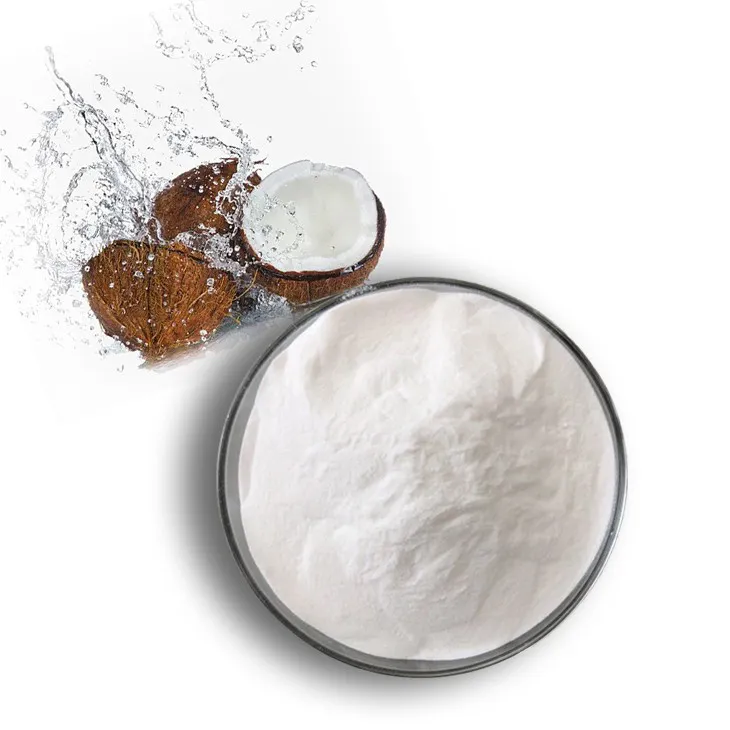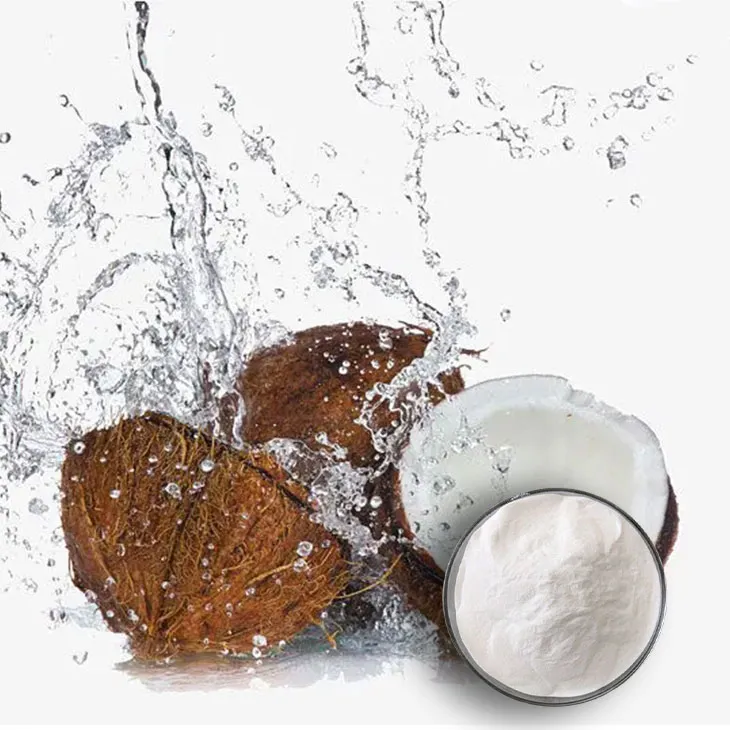- 0086-571-85302990
- sales@greenskybio.com
The best method for extracting coconut water powder.
2024-11-28

1. Introduction
Coconut Water Powder has gained significant popularity in recent years due to its numerous health benefits and versatile applications in the food and beverage industry. Efficient extraction methods are crucial to obtain high - quality Coconut Water Powder while maintaining its nutritional value and flavor. This article will explore the best methods for extracting Coconut Water Powder, considering factors such as efficiency, quality preservation, and cost - effectiveness.

2. Traditional extraction methods
2.1. Sun - drying method
- The sun - drying method is one of the oldest and simplest techniques for extracting coconut water powder.
- Procedure:
- First, fresh coconut water is collected from coconuts.
- Then, it is spread out in thin layers on clean trays or mats.
- The trays are placed in direct sunlight for several days until the water evaporates completely, leaving behind a powder residue.
- Advantages:
- It is a natural and cost - effective method as it does not require any expensive equipment.
- The lack of artificial heat sources may preserve some of the natural flavors and nutrients to a certain extent.
- Disadvantages:
- The process is highly dependent on weather conditions. Cloudy or rainy days can significantly delay or even spoil the drying process.
- There is a high risk of contamination from dust, insects, and other environmental factors during the long - exposure drying process.
- It is a relatively slow process, which may not be suitable for large - scale production.
2.2. Oven - drying method
- The oven - drying method is a more controlled alternative to sun - drying.
- Procedure:
- Fresh coconut water is poured into shallow baking pans or trays.
- The trays are placed in an oven set at a low temperature, typically between 40 - 60°C.
- The coconut water is left to dry in the oven for several hours until it turns into a powder.
- Advantages:
- It provides more control over the drying process compared to sun - drying. The temperature can be adjusted to optimize drying speed and quality.
- It is less affected by external environmental factors such as weather and can be carried out throughout the year.
- Disadvantages:
- High - energy consumption can be a significant drawback, especially for large - scale production, which can increase the cost of production.
- There is a risk of over - drying or under - drying if the temperature and time settings are not properly calibrated, which can affect the quality of the final powder.

3. Modern extraction methods
3.1. Spray - drying method
- The spray - drying method is widely regarded as one of the most efficient and advanced techniques for coconut water powder extraction.
- Procedure:
- First, the coconut water is pre - treated. This may involve filtration to remove impurities such as pulp and fibers, and sometimes pasteurization to kill bacteria and other microorganisms.
- The pre - treated coconut water is then pumped into a spray - drying chamber. Inside the chamber, it is sprayed through a nozzle into a hot air stream.
- The hot air rapidly evaporates the water content from the droplets of coconut water, leaving behind fine powder particles that are then collected.
- Advantages:
- It is a very fast process, capable of handling large volumes of coconut water in a relatively short time, making it ideal for industrial - scale production.
- The powder produced by spray - drying has a fine and uniform particle size, which is beneficial for its solubility and reconstitution properties.
- Good quality preservation as the short drying time and controlled environment help to retain most of the nutritional components and flavor of the coconut water.
- Disadvantages:
- The initial investment for spray - drying equipment is relatively high, which may be a barrier for small - scale producers.
- Proper operation and maintenance of the spray - drying equipment require skilled technicians, adding to the overall cost.
3.2. Freeze - drying method
- Freeze - drying, also known as lyophilization, is another modern extraction method with unique advantages.
- Procedure:
- The coconut water is first frozen at a very low temperature, typically below - 40°C.
- Then, the frozen coconut water is placed in a vacuum chamber. In the vacuum environment, the ice in the coconut water sublimes directly from the solid state to the gaseous state without passing through the liquid phase.
- The water vapor is removed from the chamber, leaving behind the dried coconut water powder.
- Advantages:
- Exceptional quality preservation. Since the freeze - drying process occurs at low temperatures, it causes minimal damage to the nutritional components, flavors, and bioactive substances in the coconut water.
- The resulting powder has a porous structure, which gives it excellent rehydration properties, meaning it can quickly dissolve and regain its original form when water is added.
- Disadvantages:
- The freeze - drying process is extremely energy - intensive and time - consuming, which leads to high production costs.
- The equipment for freeze - drying is also very expensive, making it less accessible for small - scale operations.

4. Comparison of different extraction methods
| Extraction Method | Efficiency | Quality Preservation | Cost - effectiveness |
|---|---|---|---|
| Sun - drying | Low. Highly dependent on weather and a slow process. | Moderate. Risk of contamination but some natural flavors may be preserved. | High. No expensive equipment required. |
| Oven - drying | Moderate. Faster than sun - drying but still relatively slow. | Moderate. Risk of improper drying affecting quality. | Low. High - energy consumption. |
| Spray - drying | High. Can handle large volumes quickly. | Good. Short drying time helps preserve quality. | Moderate. High initial investment but cost - effective for large - scale. |
| Freeze - drying | Low. Time - consuming process. | Excellent. Minimal damage to components. | Low. High - energy and expensive equipment. |
5. Conclusion
Each extraction method for coconut water powder has its own advantages and disadvantages. For small - scale production with a focus on cost - effectiveness and natural processing, the sun - drying method may be a viable option, despite its limitations. However, for large - scale industrial production where efficiency and consistent quality are crucial, the spray - drying method is often the best choice. The freeze - drying method offers the highest quality preservation but is currently limited by its high cost and energy consumption. As technology continues to advance, it is expected that the cost - effectiveness of modern extraction methods such as freeze - drying may improve, potentially making it more accessible for a wider range of producers in the future.
FAQ:
What are the main factors to consider when choosing a method for extracting coconut water powder?
When choosing a method for extracting coconut water powder, several main factors need to be considered. Firstly, efficiency is crucial. A high - efficiency method can ensure a large - scale production in a relatively short time. Secondly, quality preservation is essential. The method should be able to maintain the nutritional components and flavor of the coconut water as much as possible. Thirdly, cost - effectiveness also plays a significant role. It includes the cost of raw materials, equipment, and energy consumption during the extraction process. Additionally, environmental friendliness and simplicity of the operation are also factors worthy of consideration.
Can traditional extraction methods still be effective in obtaining high - quality coconut water powder?
Traditional extraction methods can still be effective to some extent in obtaining high - quality coconut water powder. For example, some traditional thermal drying methods have been used for a long time. However, they may have some drawbacks. They might cause partial loss of nutrients due to high temperature during the drying process. But with proper control of parameters such as temperature and time, traditional methods can still produce relatively good - quality coconut water powder. Moreover, traditional methods are often relatively simple and cost - effective in some small - scale production scenarios.
Are there any modern advanced techniques for extracting coconut water powder?
Yes, there are several modern advanced techniques for extracting coconut water powder. One of the notable methods is freeze - drying. Freeze - drying can preserve the quality of coconut water very well as it reduces the damage to the nutrients and flavor by freezing the water content first and then removing it through sublimation. Another method is spray - drying. It has the advantage of high - efficiency production, which is suitable for large - scale industrial production. These modern techniques often require more sophisticated equipment but can result in higher - quality coconut water powder compared to some traditional methods.
How does the extraction method affect the nutritional value of coconut water powder?
The extraction method has a significant impact on the nutritional value of coconut water powder. For example, if a high - temperature extraction method is used, heat - sensitive nutrients such as vitamins and some enzymes in coconut water may be degraded, leading to a decrease in nutritional value. On the other hand, methods like freeze - drying that operate at lower temperatures can better preserve these nutrients. Additionally, improper extraction methods may also introduce contaminants or cause the loss of other beneficial components, thus affecting the overall nutritional profile of the coconut water powder.
What role does cost - effectiveness play in the selection of coconut water powder extraction methods?
Cost - effectiveness is a very important factor in the selection of coconut water powder extraction methods. In terms of cost, it includes the initial investment in equipment, the cost of raw materials, and the ongoing operating costs. For small - scale producers, a more cost - effective method might be a traditional one that requires less expensive equipment. However, for large - scale industrial production, although modern advanced techniques such as spray - drying may require a high initial investment in equipment, their high - efficiency production can reduce the unit cost in the long run. Therefore, a balance needs to be struck between cost and quality to ensure the overall competitiveness of the coconut water powder product.
Related literature
- Advanced Techniques in Coconut Water Powder Extraction"
- "The Impact of Extraction Methods on Coconut Water Powder Quality"
- "Cost - effective Strategies for Coconut Water Powder Production"
- ▶ Hesperidin
- ▶ citrus bioflavonoids
- ▶ plant extract
- ▶ lycopene
- ▶ Diosmin
- ▶ Grape seed extract
- ▶ Sea buckthorn Juice Powder
- ▶ Beetroot powder
- ▶ Hops Extract
- ▶ Artichoke Extract
- ▶ Reishi mushroom extract
- ▶ Astaxanthin
- ▶ Green Tea Extract
- ▶ Curcumin Extract
- ▶ Horse Chestnut Extract
- ▶ Other Problems
- ▶ Boswellia Serrata Extract
- ▶ Resveratrol Extract
- ▶ Marigold Extract
- ▶ Grape Leaf Extract
- ▶ blog3
- ▶ Aminolevulinic acid
- ▶ Cranberry Extract
- ▶ Red Yeast Rice
- ▶ Red Wine Extract
-
Grape Seed Extract
2024-11-28
-
Bayberry Extract
2024-11-28
-
Dandelion Root Extract
2024-11-28
-
Andrographis Paniculata Extract Powder
2024-11-28
-
Nettle leaf extract
2024-11-28
-
Senna Leaf Extract
2024-11-28
-
Tormentil Extract
2024-11-28
-
Cassia Seed Extract
2024-11-28
-
Polygonum multiflorum extract
2024-11-28
-
Ginseng Root Extract
2024-11-28





















